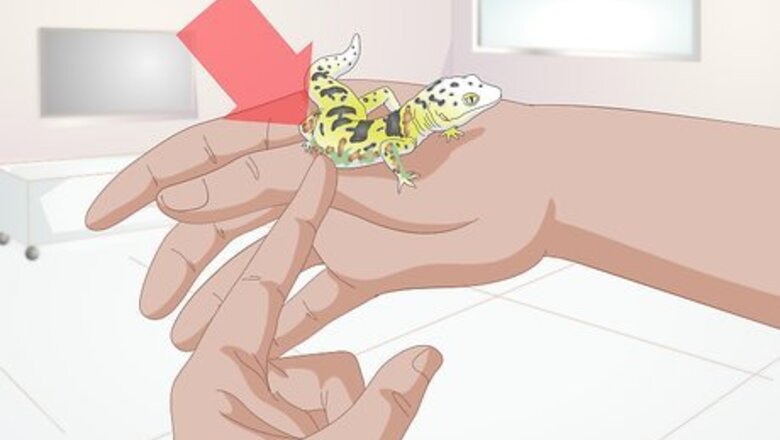
views
X
Expert Source
Audra BarriosMarine Biologist & Reptile Specialist
Expert Interview. 18 August 2020.
Fortunately, there are a few simple steps you can follow to help your leopard gecko shed and keep its skin clean.
Washing Your Leopard Gecko
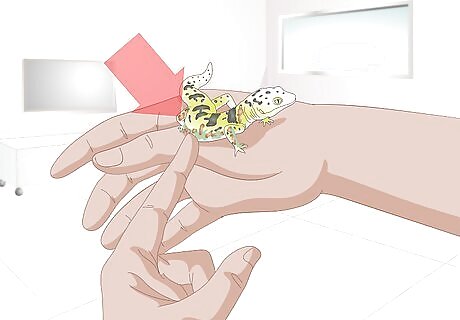
Check to see if your gecko is dirty. Leopard geckos rarely need to be bathed. In fact, over-bathing your gecko can dry out its skin and cause disease. You should only bathe your gecko if it is having difficulties shedding or a veterinarian instructs you to wash it. You can also wash your gecko if it is noticeably dirty. However, you should avoid doing so more than once a month. This method for washing your leopard gecko can also be used to clean other large lizards.

Wash your hands. Before you take your gecko out of its vivarium, you need to wash your hands with hot water and soap. This will help prevent you from transferring microorganisms to your gecko that could potentially make it ill or kill it. Be sure to thoroughly rinse the soap off of your hands too, as soap can make your gecko very ill. You should also wash your hands after handling the gecko to prevent spreading any diseases from it to others.

Fill a small container with warm water. Once you have determined that your gecko needs a bath, fill a small container with warm water up to the bottom of its belly, generally less than a half-inch (13mm). Because geckos are cold-blooded and unable to regulate their body temperature, make sure that the water is between 80 and 90 degrees Fahrenheit (27 to 32 degrees Celsius). If you can, add a little Sphagnum moss to the water to make your gecko feel more comfortable. Avoid using any soaps. These may make your gecko extremely ill. Just use warm water unless instructed otherwise. If your leopard gecko is having difficulty shedding, let it soak for 30 minutes and gently pour water over its back. This will help moisten and soften the dead skin. Be sure to avoid getting water in the gecko’s eyes, which can easily dry out. After your gecko has soaked in the water, you may try to gently pull off the dead skin with a pair of tweezers. Only do this once the skin is soft and there's no risk of hurting your gecko. Your veterinarian might also suggest adding a drop of mineral oil to the water. This will help soften the shedding skin and make it come off easier. If your leopard gecko has a fungal infection on its skin, your veterinarian make recommend that you add a little Betadine solution to the water.
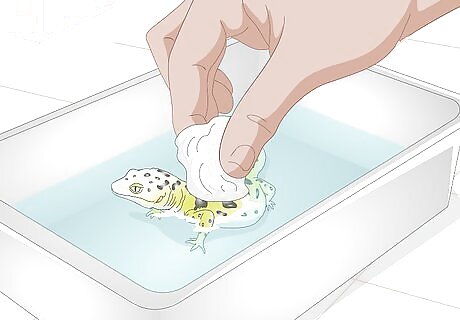
Scrub the gecko. After the gecko is comfortably in the warm water, dampen a washcloth, paper towel or a Q-tip and gently massage its skin. This will clean your gecko and remove any dead skin. Do not pull on any shedding skin. This could hurt your gecko, leading to skin damage and possibly an infection. Do not scrub too hard and rip the skin off your gecko. In places, the shedding skin will still be attached to the new skin underneath it. There will likely still be pieces of dead skin attached to your gecko when you finish. You can also rub your gecko with your fingertips. However, be sure to resist the temptation to pluck any flakes of dead skin. If you brush gently, a toothbrush may also help remove dead skin.
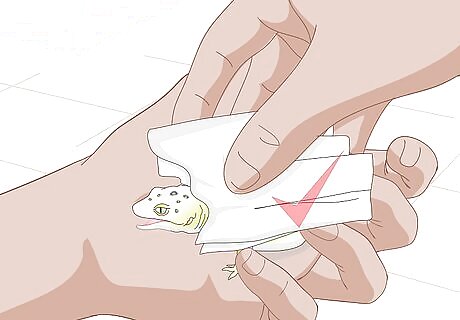
Dry your gecko. After you have properly bathed your leopard gecko, you should dry it with a cloth or paper towel. Gently wrap the gecko in the cloth, keeping its head exposed. Softly rub the animal’s body in slow circular motions with your cloth, and then gently wipe the top of its head and its vent area. Throw away any paper towels immediately, and be sure to wash and disinfect any washcloths you use. Be sure to dry your gecko quickly to keep it from getting too cold.
Caring for a Shedding Leopard Gecko
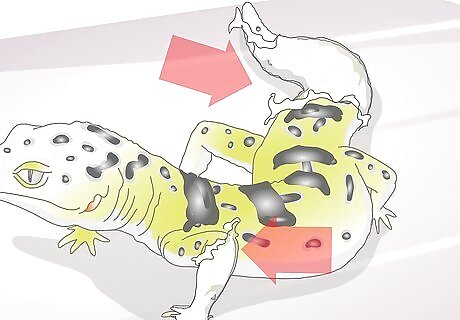
Check for excess skin build up. Over time, you may notice that your leopard gecko does not shed completely and that excess skin can collect in certain places. This can be problematic around your gecko’s tail and toes, where blood flow can become constricted. If the problem goes untreated, your gecko might lose its toes or its tail due to a lack of oxygen. Fortunately, its tail will grow back. However, the toes will be gone forever. If you notice a buildup, you may want to moisten your gecko’s skin to help the excess fall off. In nature, geckos regularly lose their toes because of constricted blood flow due to skin buildup. Although this is disconcerting, your gecko should be fine. If it does lose a toe, keep an eye on the wound to make sure that it does not become infected.

Get a moist box. In order to help your leopard gecko properly shed, provide it with a moist house or box. This is a special enclosure that you add to the gecko’s vivarium and keep moist. You can buy these boxes at your local pet store. You can also make one yourself using by cutting a hole in the side of an old plastic container and placing moist paper towels in the bottom. While your gecko is shedding you will need to moisten this box every day. If you keep your gecko properly moistened, you should avoid any difficulties when it comes to shedding.
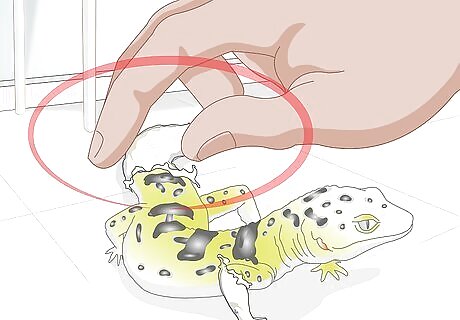
Give the gecko a massage. Moisten your fingertips or a Q-tip with a little lukewarm water and gently massage any areas where the skin has built up. Again, be gentle and do not rub so hard that the skin tears off. It should wad up and roll off in a clump.
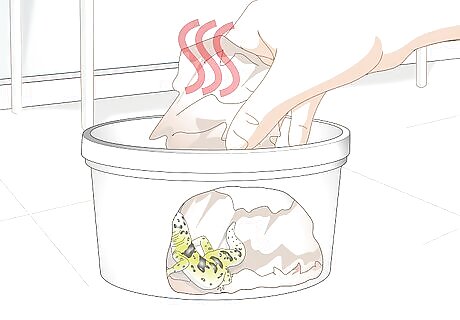
Make a gecko sauna. Add warm paper towels to your gecko’s moist box or another container. The temperature should not be more than 90 degrees Fahrenheit (32 degrees Celsius). Then place the gecko in the box and let it sit there for about thirty minutes. Once the time is up, take the gecko out and gently massage the areas of built-up skin. If you use a container that is not your moist box, make sure that you add holes so that your gecko can breathe.
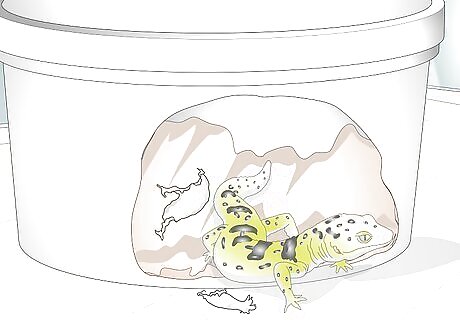
Be patient. If you are unable to get the excess skin to come off, do not force it. Scrubbing too hard or washing too often can hurt your gecko. If you give the gecko a moist place to hang out, the skin should come off. If it does not, try again after a few days or go see a veterinarian.
Keeping Your Leopard Gecko Clean
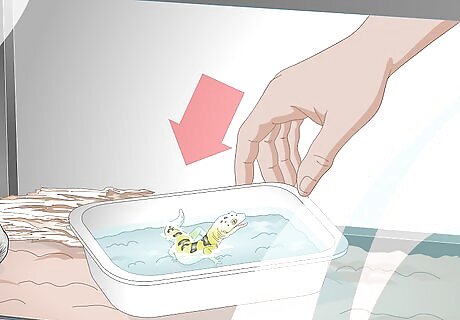
Place a bathing dish in the gecko’s habitat. Leopard geckos get most of their moisture from the crickets that they eat. However, they do benefit from a small bathing dish in their bowl. Simply take a small plastic bowl and fill it with water about a half-inch (13mm) deep. This will help with the habitats humidity and give the gecko a place to cool off it gets too hot. Maintaining the right humidity is essential to keeping your gecko’s skin healthy. Be sure to replace the water every day.
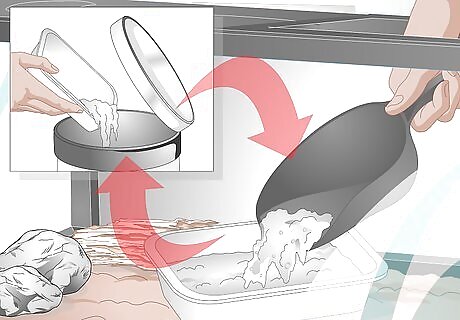
Replace the sand. After about six months, the sand in your gecko’s vivarium with become soiled and need to be replaced. Removing the dirty sand and replacing it with fresh sand will help prevent your gecko from developing any skin issues. It will also help keep your gecko clean and require fewer cosmetic cleanings. You may use other materials, like newspaper or artificial turf. However, newspaper needs regular replacement, while artificial turf is difficult to clean.
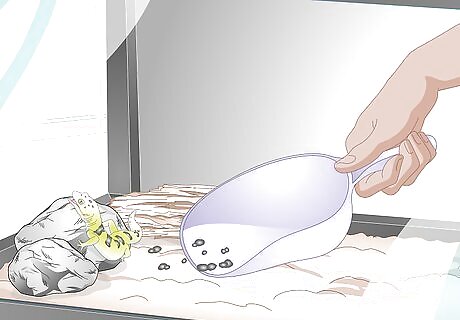
Remove any waste. Once a gecko moves into a new enclosure, it will designate one area in the habitat as its bathroom. Although this makes cleaning up after your gecko easy, you should be diligent about cleaning its waste. Determine where your gecko’s bathroom is and clean it daily. Use a small fishing net to scoop the waste out of the habitat.
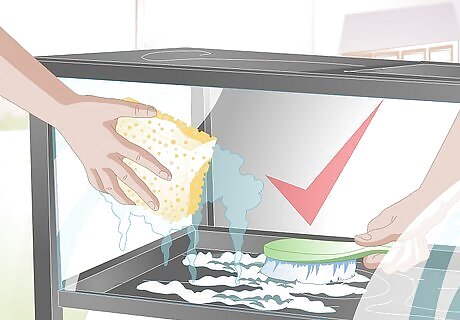
Clean the vivarium. Occasionally, you will need to fully clean out the entire vivarium. This includes scrubbing and cleaning the glass, as well as washing any bowls or containers. The best time to do this is when you replace the sand in your animal’s vivarium. However, if you feel like your vivarium is not dirty enough to be cleaned every six months, you can wait and do it once a year. Regular washings of your animal’s habitat will ensure that it stays clean and healthy.




















Comments
0 comment